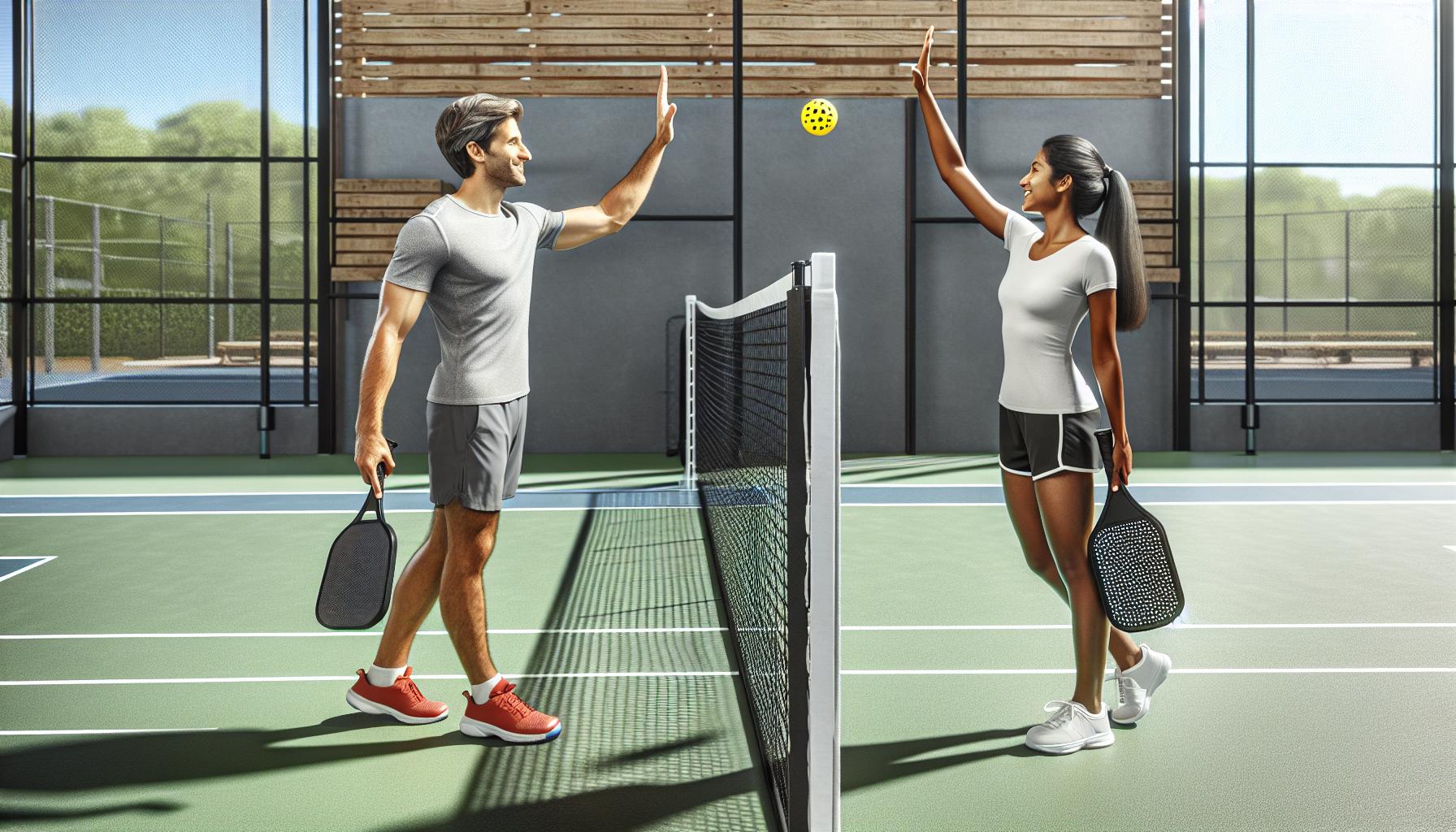Pickleball’s rise in popularity has been nothing short of meteoric, captivating players with its unique blend of tennis, badminton, and ping-pong. Yet, as more people flock to the courts, one common hurdle seems to trip up both newbies and seasoned players alike: keeping score. It’s a crucial part of the game that can seem daunting at first, but with a bit of guidance, anyone can master it.
Understanding how to keep score in pickleball is essential for anyone looking to play seriously or just have fun with friends. It’s not just about tallying points; it’s about knowing when to serve, where to stand, and how to strategize. Let’s dive into the step-by-step process that’ll have you keeping score like a pro in no time.
Pickleball Scoring Basics
Pickleball scoring may initially appear complex to newcomers, but breaking it down into its basic components simplifies understanding. This section delves into the fundamentals of keeping score in pickleball, aiming to equip players with the knowledge they need to score games confidently.
Pickleball is played either as singles or doubles, with the scoring method remaining consistent across both formats. A standard game is played to 11 points and the winning side must lead by at least 2 points. In tournament play, games may extend to 15 or 21 points, adhering to the same 2-point lead rule.
Key components to remember include:
- Serving: The right to serve switches between teams or players in a sequence that depends on the score and the game’s progression. In doubles, both members of a team will serve before the serve transitions to the opposing team, except at the beginning of the game where the first serving team has only one serve.
- Scoring sequence: The score in pickleball is called out in a specific three-number sequence, indicating the serving team’s score first, the receiving team’s second, and lastly the server number (1 or 2 in doubles). For example, “5-3-2” indicates the serving team leads with 5 points, the receiving team has 3 points, and the second player on the serving team is serving.
- Earning points: Points can only be scored by the serving team. If the serving team wins the rally, they score a point; otherwise, the serve transitions to the other team or the other player on the team in doubles.
The following table summarizes who scores under different scenarios:
| Scenario | Can Serve? | Can Score? |
|---|---|---|
| Serving team wins the rally | Yes | Yes |
| Receiving team wins the rally | No | No |
It’s essential for players to grasp that the game’s rhythm and momentum can shift significantly based on serving sequences and scoring opportunities. Mastering the nuances of when and how points are scored, and how serves rotate, can drastically impact a team’s or player’s strategy for each match.
Serving Rotation

Understanding the serving rotation in pickleball is crucial for players to not only keep track of who serves next but also to employ strategic placements and rotations during gameplay. In both singles and doubles matches, the serve initiates the point and sets the tone for the rally.
In singles, the server continues to serve until they commit a fault, at which point the serve transitions to the opponent. This rotation persists throughout the match, with players alternating serves. It’s a straightforward process, yet mastering it demands consistent focus and awareness of one’s position in the scoreline.
Doubles matches introduce a more complex serving rotation that can initially seem daunting to beginners. At the start of the game, only one player from the serving side gets to serve before the serve transitions to the opponents. This is often referred to as the “two-serve” rule. Once the serve shifts to the opposing team, both players have the opportunity to serve and score points until their team commits two faults. This cycle of alternating serves between teams continues throughout the match.
To further explain, when the first server of the serving team loses the point, the serve goes to the second server of the same team. If the second server also loses the point, then the serve moves to the opposing team, and the same rotation applies. Importantly, the initial serve of each team at the beginning of each game starts from the right-hand court, indicating that the serving team’s score is even.
Here are some Key Points to remember about serving rotation in doubles:
- The server’s score determines which side of the court the serve is made from. An even score means serving from the right side, while an odd score signifies serving from the left.
- The serving team must call out three numbers before each serve: their score, the opponents’ score, and the server number (either one or two), ensuring clarity and fairness in the serving rotation.
- In the event of the serving team winning a point, the servers switch sides, maintaining the sequence and adding a layer of strategy to the serving positions and potential play formations.
This serving rotation strategy involves a good deal of tactical awareness and adaptability. Teams often develop specific patterns and preferences based on their strengths, weaknesses, and the match’s current dynamics. Players must be keen observers and quick thinkers, ready to adjust their serving strategy and positioning to exploit their opponents’ vulnerabilities effectively.
Calling the Score

In pickleball, calling the score before each serve is crucial. This transparency ensures both teams are clear about the game’s progress and prepared for the next play. Unlike some sports, the serve in pickleball is directly linked to the score announcement, making this step inseparable from gameplay.
The scoring call in pickleball has a unique format: it’s a sequence of three numbers. The first number represents the serving team’s score, the second number is the receiving team’s score, and the third number indicates which serve it is for the team that’s currently serving in doubles matches – either the first or second serve.
For example, if the serving team has 4 points, the opposing team has 2 points, and it’s the first server for the serving team, the score would be called as “4-2-1”. This system helps keep everyone on the court, including spectators, in tune with the match’s status.
- Clarity and Loudness: The server must call the score loud enough for the opponents, their teammate, and the referee (if applicable) to hear. This clarity prevents disputes and confusion, maintaining the game’s flow.
- Sequence Matters: Always follow the sequence of server’s score-receiver’s score-server number during doubles. Mixing up this order can lead to confusion about who is supposed to serve and from which side.
- Pause for Acknowledgment: It’s considered good practice to pause briefly after calling the score. This pause allows a moment for players to contest the call if there’s a disagreement or request a clarification without interrupting the serve.
Understanding and adhering to the practice of calling the score before each serve enriches the gameplay. It demands attention and encourages players to remain fully engaged throughout the match. More importantly, it adds a layer of strategy to the game, as players must be mindful of their and their opponents’ scores to make tactical decisions.
Moreover, this process emphasizes sportsmanship and integrity within the game. By openly stating the score, players demonstrate honesty and foster a respectful environment. It reflects the essence of pickleball as a sport where fairness and competitive spirit coexist.
Incorporating these practices into gameplay not only enhances the experience for everyone involved but also helps to uphold the core values of pickleball. Through clear communication and mutual respect, players can ensure that every match is played in the true spirit of the game.
Winning the Game

In pickleball, reaching the endgame is as thrilling as it is strategic. Winning isn’t just about having the most points; it’s about understanding the rules that guide how those points lead to victory. A game is usually played to 11 points, but there’s a catch; the winning team must lead by at least 2 points. This means a game can extend well beyond 11 points if the teams are closely matched.
The journey to winning involves a consistent focus on scoring through serving and volleying within the boundaries of the court. Only the serving team can score points, which emphasizes the importance of maintaining the serve and capitalizing on each opportunity to score. This dynamic keeps the game exciting and competitive, as the receiving team must break the serve to gain the chance to score.
In doubles play, coordination between partners is key. Players alternate serves whenever a point is scored, and keeping track of who serves next is vital to maintaining the flow of the game. This not only ensures compliance with the rules but also establishes a rhythm that can be advantageous for strategic play.
Here are some highlight points on winning the game in pickleball:
- Games are played to 11 points, but a win requires at least a 2-point lead.
- Only the serving team can score points.
- In doubles, partners alternate serves after each point scored.
In matches with more competitive stakes, games might be set to 15 or even 21 points, with the same 2-point lead requirement for victory. This extension adds to the game’s intensity, as endurance and strategic planning become increasingly important. Teams must adapt their strategies and stay vigilant to secure the win.
Maintaining a strong service game is crucial for victory. Failure to serve properly or violations like “foot faults” can quickly turn the tide of the game. Players must practice and master their serves, as well as their responses to their opponents’ strategies.
The psychological aspect of nearing the game-winning point cannot be overstated. Players often feel the pressure as they inch closer to victory, which can affect their performance. Staying composed, keeping the communication lines open with partners, and focusing on the immediate play rather than the outcome are essential strategies to crossing the finish line successfully.
Conclusion
Mastering the art of keeping score in pickleball is a blend of understanding the rules, strategic play, and mental toughness. Whether it’s aiming for that 11-point win with a 2-point lead or navigating the pressures of a more competitive 15 or 21-point game, the key lies in maintaining the serve and creating a synergy between partners. Remembering to avoid common pitfalls like foot faults while staying cool under pressure will not only keep the game fair but also enjoyable. With these insights, players can step onto the court with confidence ready to enjoy every serve and volley. So grab your paddle and let the game begin!














0 Comments